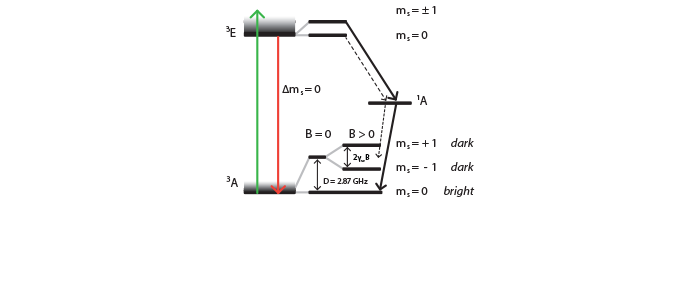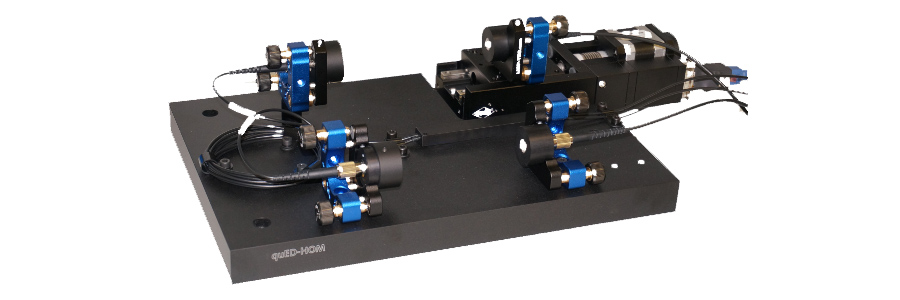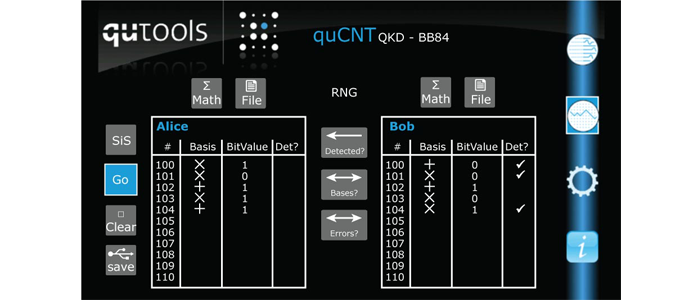The quEDU is a platform for various quantum physics experiments. It contains single photon detectors and time tagging electronics for data acquisition and analysis as well as digital interfaces to control the experiments.
The quEDU and its experiment boards combine the latest achievements in quantum optics technology into an easy-to-use system for academic, research and applied purposes with high precision. Advanced models for scientific purposes are also available, with high performance to meet the requirements of state-of-the-art physics experiments.
The qutools Quantum Education kit is designed with educators in mind. It’s the easiest and most reliable way to explain the complex phenomena of quantum mechanics by generating and analyzing polarization-entangled photon pairs or manipulating electron spins in a diamond.
Experiment Boards
The quEDU can be connected to various photon sources or experimental boards with optical setups like a Michelson Interferometer or a NV center.
+ NV Nitrogen Vacancy Centers
Quantum Sensing Education by NV-Centers
The NV experiment board allows you to experience the properties of nitrogen vacancy centers in diamond, such as NV center fluorescence, electron spin manipulation, optically detected magnetic resonance, and magnetic field sensing of samples.
At the heart of the NV is a green laser focused on the nitrogen-doped diamond through a microscope objective. The diamond begins to fluoresce in the red wavelength range. This light is collected by the objective and, after some filtering, is coupled into a fiber. The fiber is connected to the quEDU and the fluorescence can be analyzed.
The diamond sample itself is in close proximity to a microwave antenna and is surrounded coils producing a user defined homogeneous magnetic field. In addition, the quEDUs included pattern generator is precisely controlling pulse sequences for laser, microwave, and readout, enabling a multitude of spin-control experiments.
+ ED Entanglement Demonstrator
Entangled Photon Pairs: Ready to violate Bell’s inequalities
The ED design combines recent achievements of quantum optics technology into an easy-to-use system for academic, research and applied purposes with precise accuracy. Advanced models for scientific purposes are available as well, with a high performance meeting the requirements of state-of-the-art physics experiments. See how the SPDC source works.
+ ED-MI Michelson Interferometer
Demonstrate the wave nature of single photons through their interference or build a quantum eraser.
Single Photon Michelson Interferometer Add-On for the quED.
Interference is generally considered to be a wave phenomenon. Curiously it also works with single quantum objects. Use the ED-MI Michelson Interferometer add-on together with the quEDU to show that this is the case. (The photograph shows the motorised version.)
+ ED-HBT Hanbury Brown Twiss
Perform the “Grangier Experiment”, explore the particle nature of single photons with a Hanbury Brown & Twiss setup and build a quantum random bit generator.
Hanbury Brown & Twiss Setup for Heralded Single Photon Sources.
Photons (or generally quantum objects) sometimes also behave like particles. With this add-on you can show that photons can not be split up. You can also explore a simple quantum random bit/number generator and use it in combination with the quED-MI to show wave and particle nature of photons in one experiment.
+ ED-HOM Hong–Ou–Mandel Effect
Experience the purely quantum 2-photon interference effect by revealing the Hong-Ou-Mandel dip.
Hong-Ou-Mandel Interferometer Demonstrating 2-Photon Interference.
When you have two indistinguishable photons and each of them hit one input of a beam splitter, they exit the beam splitter together in one output port. This is an effect you cannot demonstrate with bright light, but with this add-on you can.
+ ED-QKD Quantum Cryptography
Securely distribute a secret key between Alice and Bob with the BB84 protocol.
Quantum Cryptography Add-On for the ED.
One of the most popular industrial applications for quantum phenomena right now is quantum cryptography, or better, quantum key distribution. With this add-on, you can use weak coherent pulses to simulate realistically how a secure communication between two parties (Alice and Bob) is made possible by the BB84 protocol in a real environment.
+ ED-TOM Quantum State Tomography
The quED-TOM let you determine the full quantum state density matrix that defines all properties of either a single photonic qubit or even the two-qubit entangled or non-entangled state that can be produced in the quED source.
Quantum State Tomography Setup
A quantum mechanical state can not be determined using only a single measurement. But, if you have an ensemble of equally prepared states, as, e.g., by our SPDC source, there is a procedure that makes the complete determination of the quantum state, i.e. its density matrix, possible.

 Interferometers
Interferometers Time-Tagger
Time-Tagger Quantum Physics Kits
Quantum Physics Kits




























